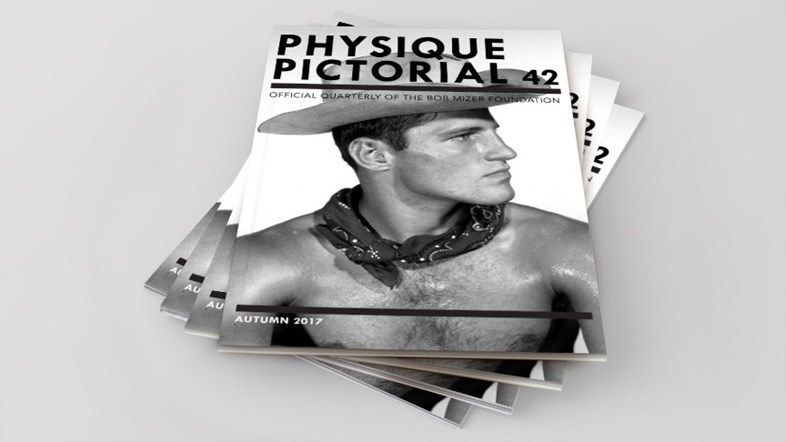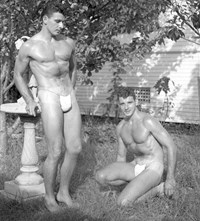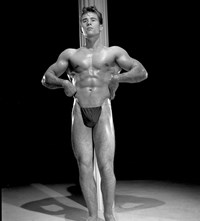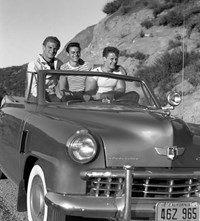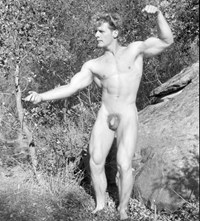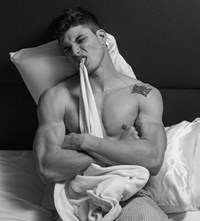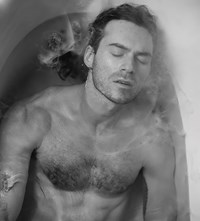As seminal gay men’s mag Physique Pictorial relaunches, we explore the life and work of its founder: Bob Mizer
- TextTed Stansfield
Before Mapplethorpe, Weber and Ritts, there was Bob Mizer. Born on 27 March 1922 in Hailey, Idaho, the photographer and filmmaker was one of the first people to create and disseminate material for gay men, which started off as simple black and white photographs of young bodybuilders. He’s sort of like the father of male erotica and his story, says the president of the Bob Mizer Foundation, Dennis Bell, is “the story of the rise of visual male physique culture itself”.
Mizer was shooting homoerotic imagery from the early 1940s, back when gay men were still subject to “sodomy laws” and the “distribution of obscene material” was still a federal crime – one he was convicted of. But Mizer prevailed though and, in 1951, founded the first all-nude and all-male magazine: Physique Pictorial. More brawn than porn (at least to start with), the periodical featured photographs of oiled, muscled men in posing straps – images that influenced Mapplethorpe and David Hockney, among others.
Following his death in 1991, Miles Chapman acquired a massive collection of Mizer’s possessions – a portion of which was photographed by Dham Srifuengfung for the A/W17 issue of Another Man. Stored in a cupboard in west London, this collection includes the full run of Physique Pictorial, thousands of photographs, paintings and drawings by Tom of Finland and other “Michelangelos and Raphaels of mid-century gay art”.
Though Physique Pictorial shuttered in 1990, this year the Bob Mizer Foundation relaunched the magazine. Here, we preview the new issue and speak to Bell about Mizer’s extraordinary life and work.
Another Man: What’s Bob Mizer’s story?
Dennis Bell: Bob was a young photographer in the early 1940s when he packed up his camera to shoot bodybuilders on Santa Monica’s famous Muscle Beach, and it wasn’t shortly after that he realised his hobby could someday become a career in commercial photography. He founded the Athletic Model Guild (AMG) in 1945 and began shooting images of models in the Los Angeles house where he lived his entire life. He sold those images of oiled, muscled men in posing straps to a small but growing number of clients, and at the time, the innocuous act of simply sending those photos through the mail carried with it the great risk of jail time. Bob managed to stay under the radar of the US Postal Service and the feds until a few years after he launched his flagship periodical, Physique Pictorial. In 1954, he was convicted of unlawful distribution of obscene material through the US mail.
Thankfully, Bob emerged from that dark period in AMG’s history with more conviction and resolve than ever. He continued to build the AMG empire, regularly producing short films and adding thousands more models to the pages of Physique Pictorial, along with his own musings and ramblings about freedom of artistic expression, freedom of speech, the evils of censorship, and everything in between.
“...the innocuous act of simply sending those photos through the mail carried with it the great risk of jail time” – Bob Mizer
A groundbreaking 1968 US Supreme Court ruling would change the trajectory of Bob’s career forever. The court ruled for the legality of sexualised nudity, and with that decision, the posing straps came off of Bob’s models throughout his movies and in the pages of Physique Pictorial. His empire expanded to multiple buildings on land surrounding the main house, where he conducted business, housed models themselves, and began shooting them in glorious colour with the same whimsy and playfulness he had employed since the beginning.
Bob was known for both his perfectionism and his steadfast commitment to his work. He maintained rigorous daily work schedules as he aged, and he always documented his daily activities, his health, his diet, and everything in between in a series of journals. Bob’s dedication to his craft was well-known among his contemporaries and his models alike.
Eventually, however, his health did begin to decline, and he had to step back from the camera with a little more frequency. Physique Pictorial ceased publication in 1990, and Bob died in 1992 – this was long before the advent of the technology we have today that we use not only to preserve his work but to market it to a new generation of physique enthusiasts. So, in that sense, I’d like to think the realisation of Bob Mizer’s vision and dream are just beginning. We’re always finding new, fresh ways to raise awareness of Bob’s legacy, and the relaunch of Physique Pictorial is just one of the several ways we can accomplish that goal.

AM: What was so revolutionary about Physical Pictorial’s representation of the male body?
DB: Although Bob Mizer made sure the text of Physique Pictorial centered on the discussion of how to stay fit, how to eat well, how to exercise, how to live a clean life, there’s no doubt that the magazine sexualised the models who posed throughout its pages. I see it as a knowing wink to the gay community of post-war America, whose members were understandably closeted and underground. The magazine was small enough that it could be easily concealed in any number of places and enjoyed in private. For the very first time, here was a publication that men could enjoy, and it’s purpose really was twofold – to act as an homage to traditional masculinity, and to provide an outlet of sexual desire for gay men. To that end, the magazine has aged well and, in my opinion, continues to fulfill those purposes.
“I see [Physique Pictorial] as a knowing wink to the gay community of post-war America, whose members were understandably closeted and underground” – Dennis Bell
AM: What was its reception like?
DB: Obviously, when it launched in 1951, the growth of Physique Pictorial was sluggish, primarily due to the nature of its content. Bob was always acutely aware that the puritanical society in which he lived viewed his work as obscene and sinful, so he had to practice the utmost discretion and care when marketing the magazine. There were few ways to market it in mainstream media, and so many subscribers only learned about it through word of mouth.
In addition to being a talented photographer, filmmaker and artist, Bob was masterful at networking and connecting with other male physique photographers. He didn’t view them as competition, but as added potential supporters who could help spread the message they were all trying to disseminate. Bob promoted other photographers such as Bruce of LA in Physique Pictorial, and he published artwork by illustrators such as George Quaintance and Harry Bush. This inclusion ensured that those partners would aid him in turning more men onto Physique Pictorial. It was a strategy that absolutely worked for him.
AM: How has it gone on to influence visual culture?
DB: Artists such as David Hockney and Robert Mapplethorpe count Mizer among their artistic influences. On a larger scale, it would be folly to dismiss some of Mizer’s works as simply camp. His images have been installed in art exhibitions in galleries the world over, and his films have been screened for international audiences. Scholars, researchers, and academics include Mizer in their own peer-reviewed articles and studies. More than just visual culture, it has become apparent in the years since Mizer’s death that he has influenced the arts, LGBT studies, academia, and more.
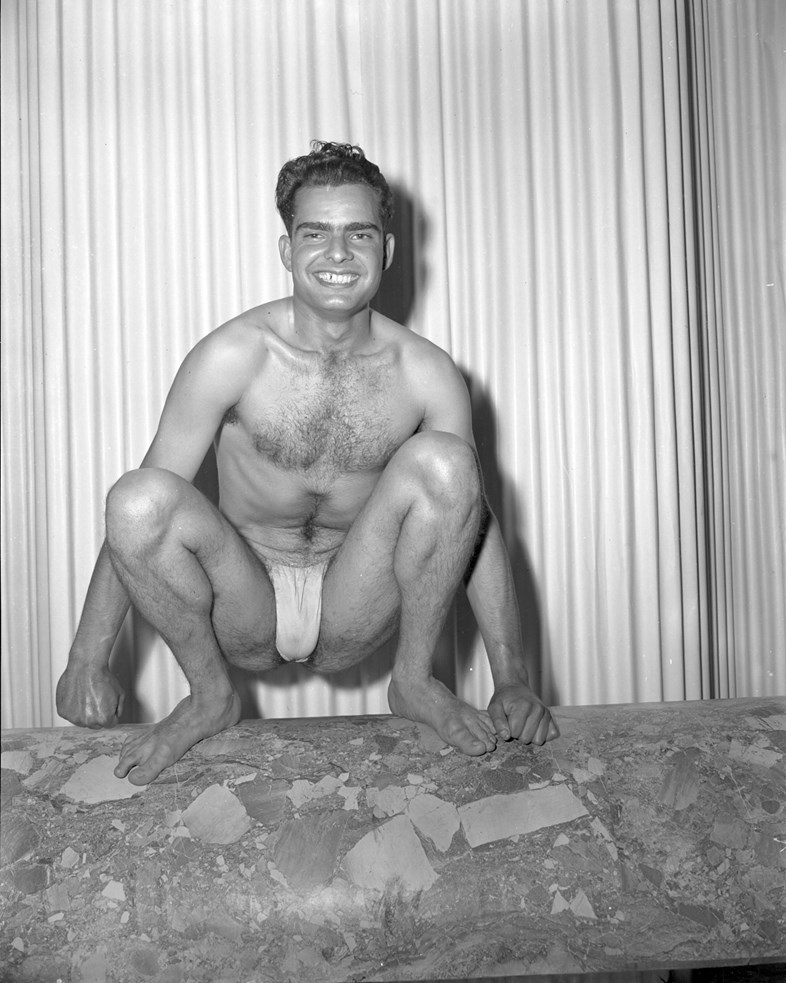
AM: Why did you decide to bring the magazine back?
DB: The Bob Mizer Foundation is in the middle of a lot of exciting projects and positive change this year, including the launch of a new video streaming website called PosingStrap.TV and our transition to a building in downtown San Francisco. The relaunch of Physique Pictorial is yet another project that we hope will raise awareness of Bob Mizer’s life and times. Since this year marks the 25th anniversary of his death, I thought this would be an ideal time to revive the magazine and pick up exactly where it left off – in fact, our Autumn 2017 issue is categorised as volume 42, instead of volume 1, since Bob’s last issue was #41. Hopefully, that sends a clear message that we are trying to build upon the work that Bob Mizer started, not reinvent it completely.
AM: How will it be different to the previous issues?
DB: Actually, what I hope readers will find most interesting are the similarities our relaunched Physique Pictorial share with the original. Each issue will prominently feature never-before-seen photos of an original Mizer model (our Autumn 2017 issue’s model is John Apache). It will maintain insight into other artists whom Mizer would have considered his contemporaries, and it will still showcase up-and-coming male physique and experimental photographers, as well as bodybuilders and models.
The biggest difference that longtime readers will notice lies in our design. Our new art director, Frederick Woodruff, is an old friend of mine and we’ve been working extensively on making the layout more modern and appealing. Every design element has plenty of room to breathe. We also have a couple of longer feature articles that explore Mizer’s world, his legacy, and the Foundation in more depth. So, both verbally and visually, this new issue is going to be a real treat.
Buy the latest issue of Physique Pictorial here.
